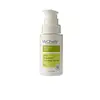What's inside
What's inside
 Key Ingredients
Key Ingredients

 Benefits
Benefits

 Concerns
Concerns

 Ingredients Side-by-side
Ingredients Side-by-side

Water
Skin ConditioningGlycerin
HumectantSodium Hyaluronate
HumectantSodium PCA
HumectantSqualane
EmollientHoney
HumectantPhospholipids
Skin ConditioningSphingolipids
EmollientRosa Canina Fruit Oil
EmollientAloe Barbadensis Leaf Juice Powder
Skin ConditioningPelargonium Graveolens Flower Oil
MaskingArginine
MaskingFructooligosaccharides
HumectantAllantoin
Skin ConditioningHamamelis Virginiana Water
AstringentAlcohol
AntimicrobialCitric Acid
BufferingPotassium Sorbate
PreservativePhenethyl Alcohol
MaskingCaprylyl Glycol
EmollientHyaluronic Acid
HumectantTrisodium Ethylenediamine Disuccinate
Water, Glycerin, Sodium Hyaluronate, Sodium PCA, Squalane, Honey, Phospholipids, Sphingolipids, Rosa Canina Fruit Oil, Aloe Barbadensis Leaf Juice Powder, Pelargonium Graveolens Flower Oil, Arginine, Fructooligosaccharides, Allantoin, Hamamelis Virginiana Water, Alcohol, Citric Acid, Potassium Sorbate, Phenethyl Alcohol, Caprylyl Glycol, Hyaluronic Acid, Trisodium Ethylenediamine Disuccinate
Water
Skin ConditioningDipropylene Glycol
Humectant1,2-Hexanediol
Skin ConditioningButylene Glycol
HumectantHouttuynia Cordata Extract
Skin ConditioningXylitol
HumectantSodium Hyaluronate
HumectantChamaecyparis Obtusa Oil
MaskingEucalyptus Globulus Leaf Oil
PerfumingHydrolyzed Hyaluronic Acid
HumectantHyaluronic Acid
HumectantCandida Bombicola/Glucose/Methyl Rapeseedate Ferment
AntimicrobialVitis Vinifera Seed Oil
EmollientCentella Asiatica Leaf Extract
Skin ConditioningChrysanthemum Zawadskii Extract
Skin ConditioningHelianthus Annuus Seed Oil
EmollientPortulaca Oleracea Extract
Skin ConditioningBetaine
HumectantDiethoxyethyl Succinate
SolventHydroxyethylcellulose
Emulsion StabilisingErythritol
HumectantSorbitol
HumectantHydroxyethyl Urea
HumectantPanthenol
Skin ConditioningC12-14 Alketh-12
EmulsifyingGlycerin
HumectantAmmonium Acryloyldimethyltaurate/Vp Copolymer
Ethylhexylglycerin
Skin ConditioningCaprylic/Capric Triglyceride
MaskingAllantoin
Skin ConditioningDipotassium Glycyrrhizate
HumectantHydrogenated Lecithin
EmulsifyingCellulose
AbsorbentPolyglutamic Acid
Skin ConditioningCeramide NP
Skin ConditioningHyaluronic Acid/Polyisopropylacrylamide Copolymer
HumectantTocopherol
AntioxidantDimethylsilanol Hyaluronate
HumectantHydrolyzed Sodium Hyaluronate
Skin ConditioningPotassium Hyaluronate
Skin ConditioningHydroxypropyltrimonium Hyaluronate
Sodium Hyaluronate Crosspolymer
HumectantPropanediol
SolventSodium Hyaluronate Dimethylsilanol
HumectantSodium Acetylated Hyaluronate
HumectantPolyglyceryl-10 Isostearate
Skin ConditioningPolyglyceryl-10 Oleate
Skin ConditioningEctoin
Skin ConditioningStearic Acid
CleansingGlyceryl Caprylate
EmollientCeramide Ns
Skin ConditioningCholesterol
EmollientPhytosphingosine
Skin ConditioningCeramide AP
Skin ConditioningCeramide As
Skin ConditioningCeramide EOP
Skin ConditioningCetearyl Alcohol
EmollientWater, Dipropylene Glycol, 1,2-Hexanediol, Butylene Glycol, Houttuynia Cordata Extract, Xylitol, Sodium Hyaluronate, Chamaecyparis Obtusa Oil, Eucalyptus Globulus Leaf Oil, Hydrolyzed Hyaluronic Acid, Hyaluronic Acid, Candida Bombicola/Glucose/Methyl Rapeseedate Ferment, Vitis Vinifera Seed Oil, Centella Asiatica Leaf Extract, Chrysanthemum Zawadskii Extract, Helianthus Annuus Seed Oil, Portulaca Oleracea Extract, Betaine, Diethoxyethyl Succinate, Hydroxyethylcellulose, Erythritol, Sorbitol, Hydroxyethyl Urea, Panthenol, C12-14 Alketh-12, Glycerin, Ammonium Acryloyldimethyltaurate/Vp Copolymer, Ethylhexylglycerin, Caprylic/Capric Triglyceride, Allantoin, Dipotassium Glycyrrhizate, Hydrogenated Lecithin, Cellulose, Polyglutamic Acid, Ceramide NP, Hyaluronic Acid/Polyisopropylacrylamide Copolymer, Tocopherol, Dimethylsilanol Hyaluronate, Hydrolyzed Sodium Hyaluronate, Potassium Hyaluronate, Hydroxypropyltrimonium Hyaluronate, Sodium Hyaluronate Crosspolymer, Propanediol, Sodium Hyaluronate Dimethylsilanol, Sodium Acetylated Hyaluronate, Polyglyceryl-10 Isostearate, Polyglyceryl-10 Oleate, Ectoin, Stearic Acid, Glyceryl Caprylate, Ceramide Ns, Cholesterol, Phytosphingosine, Ceramide AP, Ceramide As, Ceramide EOP, Cetearyl Alcohol
Ingredients Explained
These ingredients are found in both products.
Ingredients higher up in an ingredient list are typically present in a larger amount.
Allantoin is a soothing ingredient known for its protective and moisturizingg properties. Because of this, it is often added to products with strong active ingredients.
Studies show higher concentrations of this ingredient can promote wound healing.
Though it can be derived from the comfrey plant, allantoin is produced synthetically for cosmetic products to ensure purity.
Learn more about AllantoinGlycerin is already naturally found in your skin. It helps moisturize and protect your skin.
A study from 2016 found glycerin to be more effective as a humectant than AHAs and hyaluronic acid.
As a humectant, it helps the skin stay hydrated by pulling moisture to your skin. The low molecular weight of glycerin allows it to pull moisture into the deeper layers of your skin.
Hydrated skin improves your skin barrier; Your skin barrier helps protect against irritants and bacteria.
Glycerin has also been found to have antimicrobial and antiviral properties. Due to these properties, glycerin is often used in wound and burn treatments.
In cosmetics, glycerin is usually derived from plants such as soybean or palm. However, it can also be sourced from animals, such as tallow or animal fat.
This ingredient is organic, colorless, odorless, and non-toxic.
Glycerin is the name for this ingredient in American English. British English uses Glycerol/Glycerine.
Learn more about GlycerinHyaluronic acid is naturally found in healthy skin. It is a humectant, meaning it draws moisture to your skin.
This ingredient helps hydrate, soothe, and protect the skin.
What makes hyaluronic acid so hydrating? It has the capacity to bind or hold large amounts of water.
Fun fact: It is already naturally found in our bodies, such as the fluids of our eyes and our joints.
Studies find this ingredient to have anti-inflammatory and anti-microbial properties. This can help speed up wound-healing.
Hyaluronic acid can be irritating if the molecule has a low-molecular weight, or if the molecules are small.
One study found low-molecular weight hyaluronic acid to be pro-inflammatory, meaning some people may experience irritation. This is because our bodies use hyaluronic acid in the wound-healing process to signal to our bodies, via irritation, that something needs healing.
The same study found high-molecular weight hyaluronic acid to be anti-inflammatory.
These are some other common types of Hyaluronic Acid:
Learn more about Hyaluronic AcidSodium Hyaluronate is hyaluronic acid's salt form. It is commonly derived from the sodium salt of hyaluronic acid.
Like hyaluronic acid, it is great at holding water and acts as a humectant. This makes it a great skin hydrating ingredient.
Sodium Hyaluronate is naturally occurring in our bodies and is mostly found in eye fluid and joints.
These are some other common types of Hyaluronic Acid:
Learn more about Sodium HyaluronateWater. It's the most common cosmetic ingredient of all. You'll usually see it at the top of ingredient lists, meaning that it makes up the largest part of the product.
So why is it so popular? Water most often acts as a solvent - this means that it helps dissolve other ingredients into the formulation.
You'll also recognize water as that liquid we all need to stay alive. If you see this, drink a glass of water. Stay hydrated!
Learn more about Water